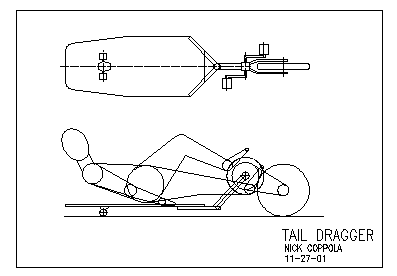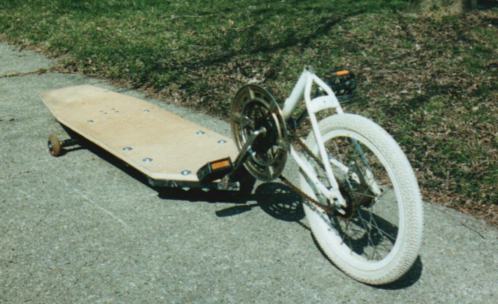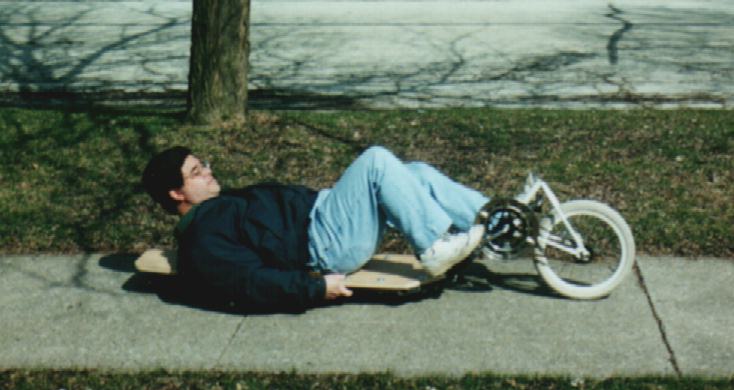How I Built an ULLWBFWDRWSLSDT
By Nick Coppola
That stands for ultra low, long wheel base, front wheel drive, rear wheel steer, lean steer, delta trike. Well, I don't know quite what to call this contraption. I like Lugetrike as it was inspired by street luge.
I wanted a low bike for my next project, but not just low I want the lowest I could go without scraping the ground. And a completely horizontal body position, no feet spinning around up above the front wheel. I wanted the smallest frontal area and the lowest air drag for an unfaired human powered vehicle.
To answer your question of why? 1. To built something different. 2. It sounded like fun.
The design is quite simple. Take the back triangle of a small bike with 16" wheels, attach it to a wood board with a sub frame and bolt on a skateboard truck and wheels. No handle bars needed. Single speed coaster brake makes it simple and uncluttered. The gearing should get it up to about 20 mph max. Good enough to test out the concept. I liked the idea of the small rear wheels too. They will have a low profile, look cool and hopefully the rolling resistance wont be too high on a smooth surface.

The biggest question I had was how would it steer? Would it steer at all, or would it whip around out of control?
Construction started on December 1st. I was all pumped up after spending the morning talking to fellow HPVers at the WISIL meeting at Sean Costin's house and started work on it immediately. The initial build time was about 3 weeks of free time. This thing is long (6 feet) and low (3 inch seat height). The weight wasn't too high at 25 lbs, considering the low tech approach I was taking. I rode it the first time in a school parking lot a few days before Christmas. Visibility past my legs wasn't as bad as I feared. The first run there was no steer at all, but it felt O.K.. After I loosened up the skate truck it turned in gentle arcs. It definitely did not have a small enough turning radius to make a turn on the street. It also had a couple of problems. It would go up on 2 wheels if leaned over hard and with loose trucks the deck rocked a lot with each pedal stroke. Other minor problems were: sliding back when pedaling hard and front wheel slipping during acceleration from a stop.

I decided that the solution to the tipping and rocking was a larger wheel track. I needed a really wide truck so I had to build my own. Actually I could have used a mountain board truck, but what fun would that be. As I took to the internet I learned about truck design and the geometry that makes it work. After two weekends of work I had the basis of a truck, an 18 inch axle swinging on a 45 degree angled pivot. The hardest part was coming up with a return to center device. This pushes on the truck and returns the axle to the neutral position and gives it stability. Without it would be extremely difficult to balance the deck. Skateboards usually use urethane bushings or some use coil springs. I got the idea of using bungees off the internet. The local Menards had 9" ones that worked. One on each side of the axle and bolted right to the deck. Hose clamps are used to keep their position on the axle. It took a lot of preload to keep it stable.

I completed the truck on a beautiful day we had in January while many were out riding. Swapping the 50mm skateboard wheels for 76mm inline ones to try to reduce rolling resistance I was out to the street in time to test it just as the sun was setting. Straight line worked fine so I leaned and it went left across the street a lean to the right and then bamm. I had hit a pot hole and bent the pivot bolt.

The damage was easily repaired with a high strength alloy cap screw. Tested again in March, the steering worked all right and was better after some adjustment of the bugees. The vibration and rolling resistance was a bit high on the rough street over here.
I added 4" scooter wheels in May and went for a test ride on a smooth 1/4 mile long driveway. The new wheels rolled smoother and faster. The handling at slow speeds was fine, but over say 12 mph it did get unstable a couple of times. Oh well, no news flash here, rear steering is inherently unstable. I call this a design exercise.
Send me an e-mail at coppola1962@yahoo.com